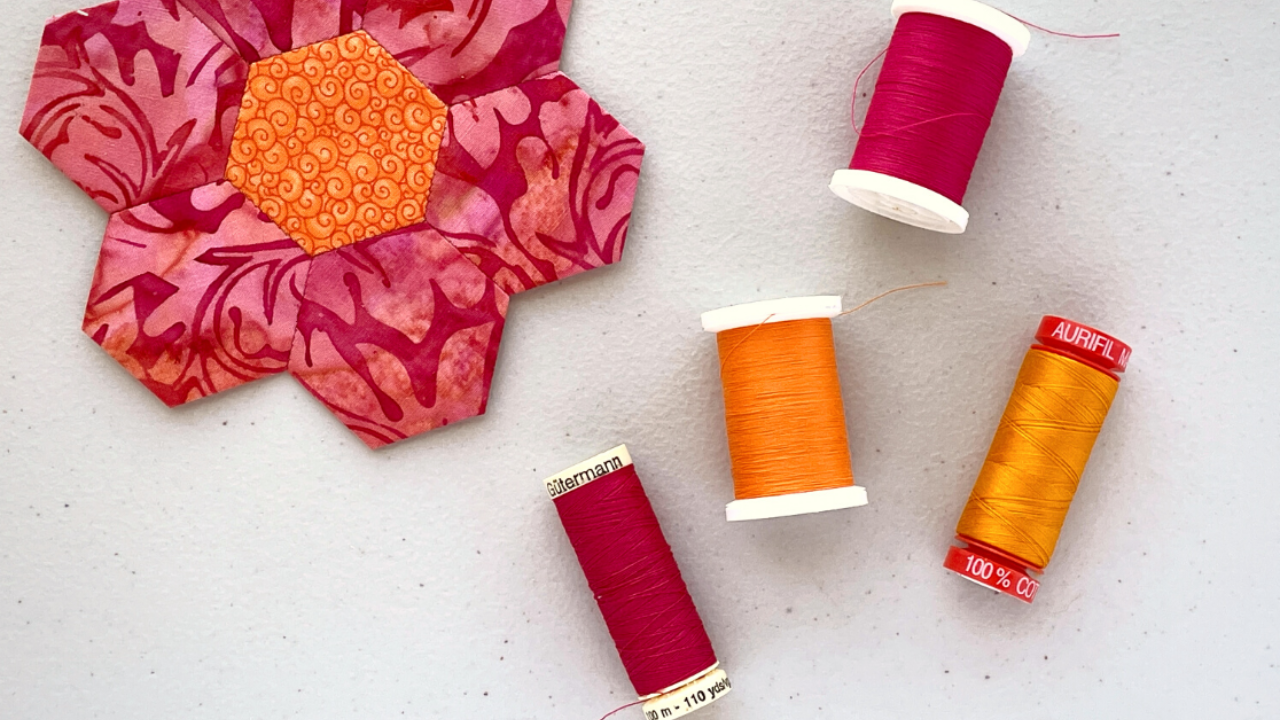
Have you ever gotten overwhelmed by the endless thread options that exist for quilters? How are you to know what is the best thread for English paper piecing when there are so many to choose from and every quilter seems to have a different favorite?
Not all sewing thread is the same. Not only are there differences in thread content - what a thread is made of - there are also differences in thread quality. In this post, you're going to discover what makes the best thread for English paper piecing and why.
Thread Strength Matters
When you run into problems with your hand stitching, it can most likely be traced to two things: the needle, or the thread. If you're experienced with EPP then you know exactly what your thread must go through as you stitch along your seam.

Before you begin stitching, your thread must be ready for its long journey through your work. It's going to be constantly dragged along the edge of a paper template with EVERY. SINGLE. STITCH.
This means there's a lot of room for error if your thread isn't performing its job well enough. One thing that can cause a lot of frustration and slow down your stitching is when your thread breaks.
We don't want to be frustrated while trying to unwind with EPP. That defeats the purpose of this lovely low-stitching process which is why it's important to use a thread that is strong enough.
Breaking Thread
There are two common reasons why your thread might break while stitching English paper piecing.
- If your needle has a rough or sharp burr inside the eye it can cause the thread to snag as you stitch. After enough times, it will eventually break.
- Certain types of thread can be more prone to breakage than others.

After you purchase all the fabric for your EPP project, it may be tempting to save on cost when buying the thread. But when it comes to English paper piecing, thread is NOT something to skimp on.
EPP is a slow process that takes a lot more time to complete than if you were to sew by machine. You are investing your precious time into your EPP project, therefore, the fewer thread breaks the better.
Trust me. Investing in a quality thread will save you the frustration and hassle of having to constantly rethread your needle because your thread keeps breaking.
So if that means spending a little more money for quality thread, I think it's well worth it in the long run. Whether you’re working with cotton, silk, or polyester thread, you'll find varying levels of quality from thread to thread. Get the good stuff.

Choosing the Best Thread for the Job
So how do you choose the right thread for sewing EPP? Before we can learn how to choose the best thread, we need to get to understand some basics of thread first.
Like yarn, thread comes with a size-indicating number. The lower the number, the thicker the thread. Sometimes you might see a thread number shown as a fraction. Don't panic, there's no quilting math involved here.
The top number simply represents the weight of the thread, while the bottom number shows you the ply, or the number of strands that are spun together. So, for example, a thread that is 60/2 has a weight of 60, and is two strands spun together. Easy peasy.
The strength of a thread is determined by the weight, the ply, and the length of fibers used to spin the thread.

A Thread for Every Job
Basting
Any color all-purpose thread can be used for thread basting. A contrasting color will help you to see your basting stitches when it's time to pull them out. So if your fabric is a light color, using a dark thread for basting will make those stitches easier to find.
Be aware though that if the thread has a lot of lint it can cause problems later on. The lint could get caught in your fabric leaving faint traces that may be visible even after you've removed your basting stitches.
40wt and 50wt are typical for all-purpose threads. If you don't want to fuss over which thread to choose and would rather play with your beautiful fabrics, you can get away with a standard 50wt and use it for both basting and piecing, and even machine quilting if you want to.

Piecing
When it comes to English paper piecing, the piecing is where our time is mostly spent. So it's important to choose a quality thread for the job, as I mentioned earlier.
Threads ranging from 50wt to 80wt are commonly used for piecing. The higher the number, the thinner the thread and the less visible the stitches tend to be on the front of the work.
Are you curious to see how different weight threads perform during piecing? In the video below, I compare the performance of three weights of polyester thread while piecing some EPP hexagons.
The three threads I compare are Coats & Clark Dual Duty XP (35wt), Gutermann thread (50 wt), and Wonderfil Decobob (80wt). Watch how each one performs by clicking the video below.
Applique
If you want your applique stitches to be as inconspicuous as possible, try a 60wt to 80wt thread. For visible applique stitches, like those used for this appliqued EPP project, try a thicker thread or even some embroidery thread like DMC Perle Cotton No. 8 thread.
Quilting
Some threads are labeled specifically for “quilting.” This means “hand quilting", not to be confused with machine quilting. Hand quilting thread may be coated with a wax to help make hand sewing easier without the need for additional thread conditioner (Haven't heard of thread conditioner? It’s fantastic! I often use it for hand sewing. This one is my favorite! )
Thread sizes ideal for quilting range from 30wt down to the very fine 100wt. For hand quilting, a thicker thread, like the Perle cotton, will be easier to work with and will create nice visible stitches. For creating invisible quilting stitches on a machine, finer threads, like 100wt Invisifil Poly, can be used.

Cotton vs Polyester vs Silk
There are three main types of thread known in the English paper piecing community. And each EPPer seems to have their favorite. There are some key differences between these types of thread that may make you want to experiment until you find your favorite.
When to Use What Thread
- Cotton Thread is soft and fairly strong. Due to its stable structure (i.e. lack of stretch), it's the best thread to use for piecing and quilting a quilt because it retains its shape. It will shrink at the same rate as cotton fabric, keeping seams smooth and strong. Working with shorter lengths while hand stitching is helpful to avoid thread shredding, a challenge some have with cotton that I mentioned above. Additionally, choosing a high quality cotton thread made with long fibers can help prevent thread breaking, as well.
- Polyester Thread has a bit of stretch to it and therefore is less likely to break. So if you pull tightly on your English paper piecing stitches, it's better to sew with polyester thread. Another major benefit of poly is that it sheds less lint than cotton. One drawback with poly is that it will not shrink in the wash, so if you are using cotton fabrics with polyester thread you may notice some pulling at the seams after washing your project, as the cotton fabric may shrink a bit while the polyester thread will not.
- Pure Silk Thread is a very strong and very fine thread. Because of this, the stitches 'sink' into the fabric, making them virutally invisible - perfect for English paper piecing and hand applique. Silk thread is also slippery, making it a challenge for some to work with.

My Top Thread Choices for EPP
I use a variety of the above-mentioned sewing threads. So what is the best thread to use for EPP? Here are my favorite threads I use for English paper piecing.
- Aurifil: This is my go-to thread. It's the one I always keep in my travel EPP kit in a light neutral color because it goes with everything. They offer beautiful color collections curated by popular designers. This low-lint cotton thread is a bit more delicate and more prone to tangling and breaking than the others I mention. So you may want to sew a bit with it before settling on some for your EPP thread stash.
- Wonderfil: This thread is brand new to my stash. I recently acquired a collection curated by Sue Daley. It has the softness of cotton but is a polyester thread. So it's nice and strong for those who pull hard on their stitches like me. At 80wt it is super fine and virtually disappears into the fabric making it great for hand piecing and applique.
- Gütermann: This is a brand that I used for years for garment sewing before I got into EPP. More recently, I found myself reaching for a spool to use for English paper piecing. I fell in love with it all over again! It's smooth, strong, and doesn't tangle while hand stitching. A winning thread all around.
- Coats & Clark: A great all-purpose polyester thread that can be found in the sewing and craft section of most large retail stores. It works great for all steps in the English paper piecing process, from basting to machine quilting. I like C&C because it's inexpensive, easy to locate, and I can always find the color I want.
Now that you know what my go-to thread brands are, what are your favorites? Come tell us in the Facebook Group.
Happy stitching!
Want More Inspiration?
Subscribe to our newsletter to get free patterns, tutorials,
updates, and inspiration delivered right to your inbox.





